Your 20% Member’s Discount expires in
Days
Hours
Minutes
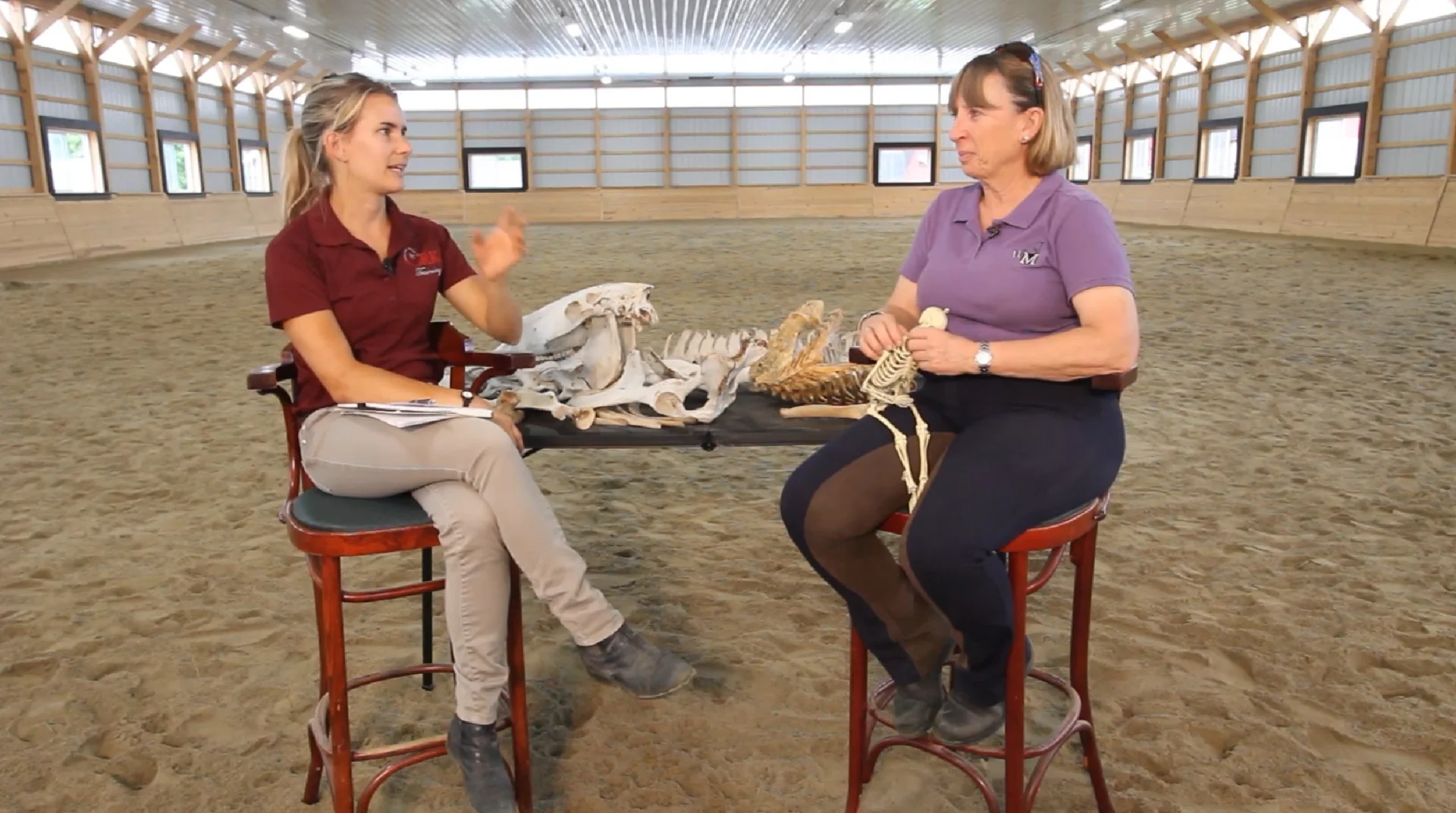
The way a horse moves – how he carries his head, moves his back, and lands with each step – determines his ability to safely carry a rider and determines what that rider feels from the saddle. Whether the horse feels balanced or light vs heavy, rushing, or doggedly slow.
Movement also affects temperament and behavior. Many behavior problems under saddle begin due to the discomfort of a horse who never learned to carry the weight of a rider effectively and so feels unbalanced or uncomfortable, triggering many resistant behaviors such as bucking, rearing, leaning, rushing, or refusing to move.
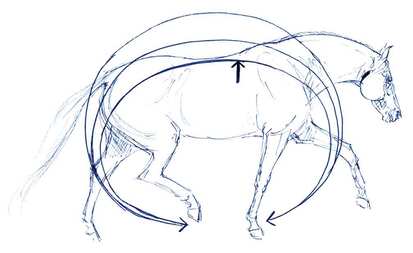
Our challenge as equestrians begins with the fact that horses were not designed to carry weight on their backs. They are a grazing species with bodies adapted for long hours wandering and chomping grass and the occasional sprint away from potential threats.
When we ask the horse to carry our weight there is a particular way they need to organize their body in order to do so effectively without pain and undue stress on joints and soft tissue structures. This is called a weight bearing posture.
Unfortunately, if you go to a local horse show or event, there are not likely to be many horses moving with good weight bearing posture. Instead you are more likely to see strained lifted necks, hollow backs, and the subsequent struggles between horse and rider… kicking incessantly to go forward, bucking in canter transitions, etc.
Besides the potential behavior problems and struggles with their riders, these horses are also more at risk of injury.
But keep looking at that horse show and you may see a horse rider pair who appear connected, soft, light and effortless in their movement and communication. The horse moves willingly without rushing and the rider remains balanced and quiet. The rider’s requests are almost invisible and the horse is “on the aids”, that destination in riding that each rider, regardless of discipline, knows they want, but isn’t sure exactly what it means or how to get there….
"A horse appropriately conditioned and trained to carry riders correctly, is likely to avoid many of the injuries that may otherwise be sustained. This underlines the need for more education of owners in appropriate musculoskeletal and behavioral conditioning as well as equine biomechanics."
How riding may affect welfare, a review article by P. McGreevy, A. McLean, P. Buckley, F. McConaghy and C. McLean
The connection between posture and movement to soundness and temperament may be obvious, but the messages about what correct movement is and how to get there are often confusing.
As riders, we’re told to “get his head down”, “make him round”, “ride the hind end”, “get him pushing”, etc, but a clear picture of what we are actually working towards often eludes us.
Developing this clear picture of weight bearing posture and good quality movement becomes the first step to achieving it consistently with your own horse and in your own riding.
Learn through seeing the skeletal system, colored dots marking joints, bells marking footfalls, and slow motion video showing correct and incorrect movement for comparison.
Understanding and recognizing quality posture and movement is the first step.
But the second step is equally important to your riding… being able to then transfer that understanding to your feel in the saddle.
Once we have developed the clear mental picture of what we are looking for in movement, we need to be able to recognize if our horse is moving effectively when we are riding. As riding skills increase, we need to be able to feel shifts of balance for correct timing of aids, and we need to be able to feel movement for clues if our horse is uncomfortable and something needs to be shifted.
To understand how your horse can move better, develop the visual image for this correct movement, and then find your feel in the saddle, I would like to invite you to join ABCs to On the Aids with Wendy Murdoch.
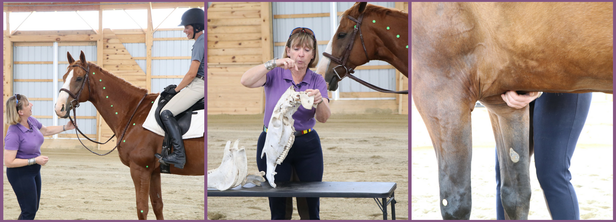
In Anatomy of Movement, we begin by understanding anatomy and how it relates to movement. Wendy explains in detail the importance of weight bearing posture from the horse and explains the true meaning of riding terms such as on the bit or on the aids, throughness, impulsion, collection and cadence.
In Seeing Movement: Good, Bad, and Ugly, you will spend time looking at different horses moving on a lunge line as well as under saddle to identify their movement patterns, such as shortening or lengthening the topline, over or under tracking and rotating the ribcage right or left.
Then in Feeling the Difference, Wendy will help you to develop the feel in your own riding through exercises on and off the horse. Each step of the way, you will receive simple homework sheets to help you apply what you are learning to the horses you ride by developing your eye and improving your feel.
In Movement of the Rider, develop your eye for the movement of the rider as well. Watch as Wendy points out and corrects imbalance and poor position in the rider, first on the spring horse and then with several riders on their own horses. You’ll see how much the horse will change as the rider finds better posture.
Finally, in Finding the Change, see how the horses can change their movement patterns and how the same horse can look completely different when they move in a different way.
In the Horse Vault, you’ll get insights into Wendy’s assessment and planning process for solving movement issues.
Watch as Wendy observes four different horses, discusses their current state, potential, and the owner’s goals for the horse, and develops a plan for each horse.
In this bonus series, Wendy provides an overview of her SURE FOOT Equine Stability Program® that is used to improve a horse’s balance, confidence, movement, and performance.
The importance of balance and how it affects the horse, posture versus conformation, and changing patterns are all covered, followed by a discussion of getting started with SURE FOOT.
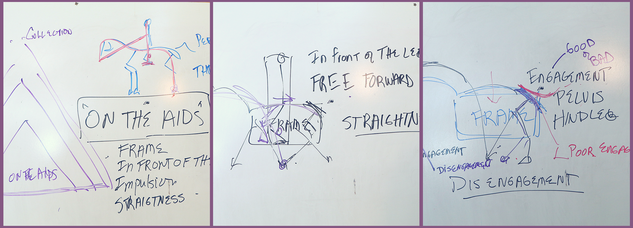
“I understand the importance of good movement, but how do I recognize it… how can I really tell if my horse is ‘lifting his back’ or ‘using his hind end’?”
“How can I teach myself to actually see these movements and know if my horse is carrying his body in a healthy way?”
These are questions I hear from students who recognize how important a horse’s posture and movement are for soundness, performance, a comfortable ride, and even the calmness of the horse, but are struggling to recognize when a horse is actually moving well.
That’s why I teamed up with Wendy to create On the Aids, to teach you how to see and feel when a horse really is On the Aids!
Wendy begins with a concise class on anatomy, and how the bone structure will relate to the horse’s movement. Then she gives an in-depth lecture on what “on the aids” really means, explaining common terms like impulsion and collection in a simple and understandable way.
Next, we watch horses on the lunge line and slow down their movement so you can see the different ways they carry themselves, for example favoring one side, landing heavier on a specific leg, or being free through the back instead of tense.
After that, Wendy works with a rider on the spring horse to look closely at rider movements and how these affect the horse’s body.
Finally, Wendy will share exercises to develop your feel, and begin simple bodywork with your horse, as well as how to apply the body work as well as the other elements of good horse management.
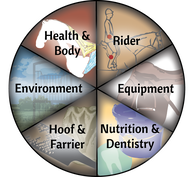
When you join the Effortless Rider Jumping Course, you’re in for life. There is no expiration date, and your access to the videos will never go away. Plus you can join in future rounds to deepen your jumping skills.
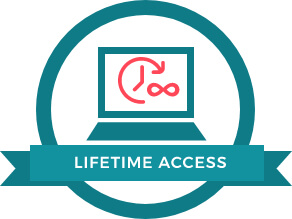
As with all our premium Courses, this is a well supported program – to make sure you keep making progress and don’t get stuck.
Ask Wendy any questions under each lesson video as you progress through the course and get invaluable feedback and insights through your Video Coaching with Wendy.
 Thank you Wendy. This was so helpful. I am very visual and your visuals really helped me understand the concepts more, and help them have a volume of sorts. I hear these words in my lessons too and I think I grouped many of the words together to mean collection, but now I understand the pieces of the puzzle and how they interact. Also, I appreciated the on the aids, meaning as I have always wondered if the 'bit' or the ability to manipulate the bit adequately, would result in 'on the bit', even though I sensed it was more about the energy and the feeling energized and with strength and enthusiasm. On the aids, seems so much more humane, and I have seen my horse collected chasing my pony around, with no rider or aids but intention, enthusiasm and focus!
Thank you Wendy. This was so helpful. I am very visual and your visuals really helped me understand the concepts more, and help them have a volume of sorts. I hear these words in my lessons too and I think I grouped many of the words together to mean collection, but now I understand the pieces of the puzzle and how they interact. Also, I appreciated the on the aids, meaning as I have always wondered if the 'bit' or the ability to manipulate the bit adequately, would result in 'on the bit', even though I sensed it was more about the energy and the feeling energized and with strength and enthusiasm. On the aids, seems so much more humane, and I have seen my horse collected chasing my pony around, with no rider or aids but intention, enthusiasm and focus!

 Thank you - all these modules are very helpful in understanding the big picture and understanding what I can do specifically to help the horse keep his back up and underneath himself.
Thank you - all these modules are very helpful in understanding the big picture and understanding what I can do specifically to help the horse keep his back up and underneath himself.

 FINALLY I understand "in front of the leg" and all that it entails. Thank you!
FINALLY I understand "in front of the leg" and all that it entails. Thank you!

 Wow. Using Joker makes it so clear how we influence our horse's movement so much for better or worse! Excellent information and well presented.
Wow. Using Joker makes it so clear how we influence our horse's movement so much for better or worse! Excellent information and well presented.

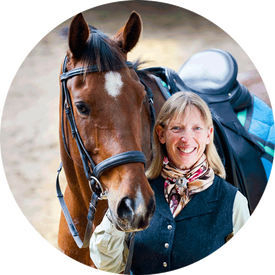
At 27 years old, Wendy had a serious riding accident, the horse she was riding reared and fell, rolling over her and pushing her femur through her hip socket. Weeks later Wendy left the hospital in a wheelchair with no opportunities for physical therapy. But her commitment to understanding the body and the connection between body and mind had begun.
Now, with over 30 years of experience as a professional riding instructor and Feldenkrais practitioner, Wendy has combined her formal education in anatomy and physiology with her time working alongside great veterinarians such as Dr Hilary Clayton and Dr Joyce Harman as well as her intensive Feldenkrais training using movement as a mode of body work. Wendy has also spent countless hours in arenas around the world working with horses and riders to help them discover where they are stuck and how to change old habits and patterns to find new possibilities for movement, balance and ease.
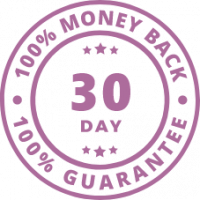
As with all of our HorseClass programs, I want you to be completely confident and comfortable joining. If you are not satisfied with this course for any reason, return it for a full refund within 30 days of joining.
I would love to have you join this session of ABCs to On the Aids!

I get it, life is busy! When you join the Effortless Rider Jumping Course, you are a member for life. You can go through the Course now or later, as often as you want and at your own pace! You can also participate fully with each live round of the Course and work on new goals.
No, you do not need to own your horse, however, you will need to have the ability to set the grids and exercises for the horse you are riding in order to get the most out of these exercises.
Yes, I am sure we will offer this course again, however, as a student in this first class, you have the advantage of being part of the first group that helps us improve and add to the course, and you will receive all the future additions for Free!
You can get started with Lesson One as soon as you join. The next lessons are released weekly, but you will have continued access to all of the content to revisit as often as you like.
This Course is designed to be as valuable to a complete novice looking to have some fun over poles or an advanced rider looking to be competitive in the showjump ring. The jumping position exercises and lessons will lay the correct foundations for Effortless Jumping, foundations that are often lacking in jump training and are the ‘groundwork’ for achieving stability over a jump for the comfort of both rider and horse.
While most of the Course content is delivered over the internet, the videos can be customized for playback in slow internet areas. If you do join and find that you can’t participate in the Course as you hoped, we offer a 30 Day Full Money Back Guarantee.
When you join The Effortless Rider Jumping Course, you have lifetime access to the entire Course, so you can go through at your own pace, and retake the Course as many times as you wish!
Absolutely! All of our courses here at CRK Training are designed to help you get more out of any lessons or clinics you are already doing. These courses help to fill in the gaps, all the information that just can’t be covered in the scope of weekly lessons.
Scroll down to the contact form below and send me a message!
5 Weeks of Online Course Content
BONUS The Horse Vault
BONUS SURE FOOT series
Lifetime Access to the Course
30 Day Full Money Back Guarantee